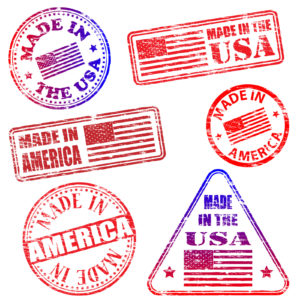 “America” includes all of the Western Hemisphere, and North America is the United States, Canada, and Mexico. So “American made” is a nebulous term.
“America” includes all of the Western Hemisphere, and North America is the United States, Canada, and Mexico. So “American made” is a nebulous term.
There are some common phrases being used to encourage people and businesses in the United States to buy home-grown or products manufactured domestically. These include “Made in the USA,” “Buy America,” and “Buy American.” Each of these terms has very different meanings. If you want to incorporate a phrase in your marketing, patronize a particular product, or do business with the federal government, be sure to understand what each term represents so you don’t mislead customers, aren’t misled when you buy, and qualify for federal procurement opportunities.
Made in the USA
The term “Made in the USA” is a commercial term the use of which is governed by rules set by the Federal Trade Commission (FTC). The purpose of FTC rules is to prevent false advertising.
Under FTC rules, if “Made in the USA” is used (expressly or implied), then all or virtually all of the product must be made within the 50 states, District of Columbia, or U.S. possessions. “All or virtually all” means that all significant parts and processing that go into the product must be of U.S. origin. That is, the product should contain no — or negligible — foreign content. The rules clarify what this means in terms of product content and assembly.
The content must be disclosed on the following items: automobiles and textile, wool, and fur products. While other manufacturers don’t have to make such disclosure, they must still comply with FTC rules if they claim to be Made in the USA.
Companies don’t need pre-approval from the FTC to use Made in the USA. However, if they falsely do so, they may be subject to penalties. A rule proposed last year would allow for a sizable civil penalty per violation. The new administration has this rule under review.
For more information, go to MadeInAmerica.com a website started in 1998 which is devoted to inspiring people to innovate, build, and buy products from the United States.
Buy America
Buy America is not an advertising term. It’s a requirement for certain industries. Enacted in 1982, the Buy America Act is only applicable to transit-related procurements by the federal government valued at over $100,000. This all requires that any product with certain content (e.g., steel or iron) must be sourced in the U.S. The Department of Transportation (DOT) final rule details the application of the law. Similarly, the Airports and Airways Facilities Improvement Act of 1982 requires content for products used to manufacture airplanes and airways be sourced in the U.S.
Buy American
Another procurement-related law—Buy American Act of 1933—requires the federal government to only purchase products over a certain value if they are manufactured in the U.S. This means that over 50% of the components are made domestically. However, over the years, waivers have been given to permit government acquisitions despite the Buy American Act. Recent executive orders have attempted to put more teeth into this law. A couple of examples:
- President Trump’s Executive Order 13811 directs, among other things, a change in the Federal Acquisition Regulation (FAR) to increase the “component test” (e.g., the steel component, which must be more than 50% by cost, should be increased to more than 95%).
- President Biden’s Executive Order on January 25, 2021, directs updating and centralizing the Made in America waiver process.
Final thought
To help the U.S. economy continue to recover from the pandemic, there is continued focus on patronizing U.S. companies. Understanding terminology may help your business make key decisions about selling, buying, and taking advantage of certain government procurement opportunities.


